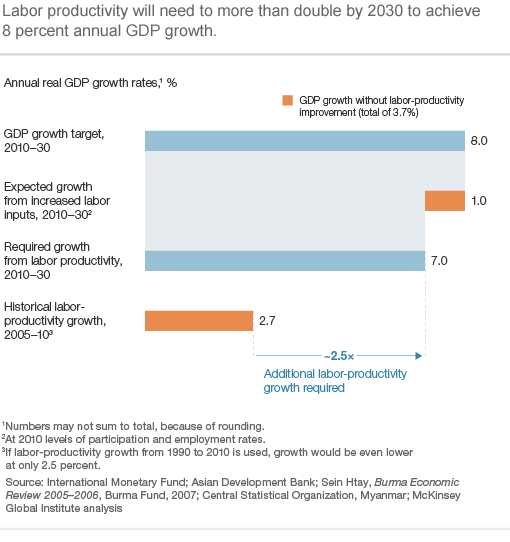Myanmar is a highly unusual but promising prospect for businesses and investors—an underdeveloped economy with many advantages, in the heart of the world’s fastest-growing region. Home to 60 million inhabitants (46 million of working age), this Asian nation has abundant natural resources and is close to a market of half a billion people. And the country’s early stage of economic development gives it a “greenfield” advantage: an opportunity to build a “fit for purpose” economy to suit the modern world.
Managed well, Myanmar could conceivably quadruple the size of its economy, from $45 billion in 2010 to more than $200 billion in 2030—creating upward of ten million nonagricultural jobs in the process. Myanmar’s moment: Unique opportunities, major challenges, a new report from the McKinsey Global Institute, discusses the challenges of meeting this ambitious goal and points to several areas that could help unlock high growth.
The report finds that if current demographic and labor-productivity trends continue, Myanmar could grow by less than 4 percent a year. But it has the potential to grow by 8 percent a year if it accelerates the rate of annual labor-productivity growth, to 7 percent, from 2.7 percent—a difficult but not unprecedented feat (exhibit).
Exhibit

Only a diversified economy can double its labor productivity; relying exclusively on energy and mining would not suffice. All the fundamentals—political and macroeconomic stability, the rule of law, enablers such as skills and infrastructure—must be in place. The report also finds that four areas, which have thus far received little attention, could underpin growth and productivity.
1. Harnessing digital technology. Myanmar is beginning its economic-development journey in the digital age, when mobile and Internet technology are increasingly affordable. Harnessing these tools to the fullest could help the country leapfrog to a more advanced stage of development, but that would call for an aggressive telecommunications-infrastructure plan.
2. Supporting a structural shift toward manufacturing. While other emerging economies have experienced a structural shift away from agriculture toward manufacturing, Myanmar’s reliance on agriculture has increased. Today, the country’s manufacturing sector is small in absolute terms—less than half the size of Vietnam’s—but it has the potential to be Myanmar’s largest by 2030.
3. Preparing for urbanization. The vast majority of Myanmar’s citizens live in rural areas, but this is likely to change rapidly. The share of the population in large cities could double, from just 13 percent today to around 25 percent in 2030—an additional ten million people, or two cities the size of Yangon. Myanmar would benefit from preparing for this change through investment, planning, and a shift to local governance.
4. Connecting to the world. Myanmar must consider the best way of reconnecting to the global economy through investment, trade, and flows of people. The nation potentially needs more than $170 billion of foreign capital to meet its overall investment requirement of $650 billion and should develop a targeted strategy to attract it. Trade volumes are not only low but also undiversified, and Myanmar could expand its trade opportunities and increase population flows to encourage knowledge transfers, the building of skills, and expanded tourism.
To implement that agenda, Myanmar’s government is likely to require more capacity and may consider setting up a delivery unit dedicated to solving problems and driving the implementation of change. The nation’s businesses could consider their opportunities in different markets, quickly reach international quality standards, and explore foreign partnerships. International companies must move fast, be prepared to commit to Myanmar for the long term, and consider partnerships with local firms.


